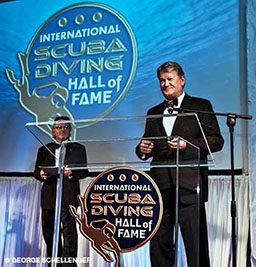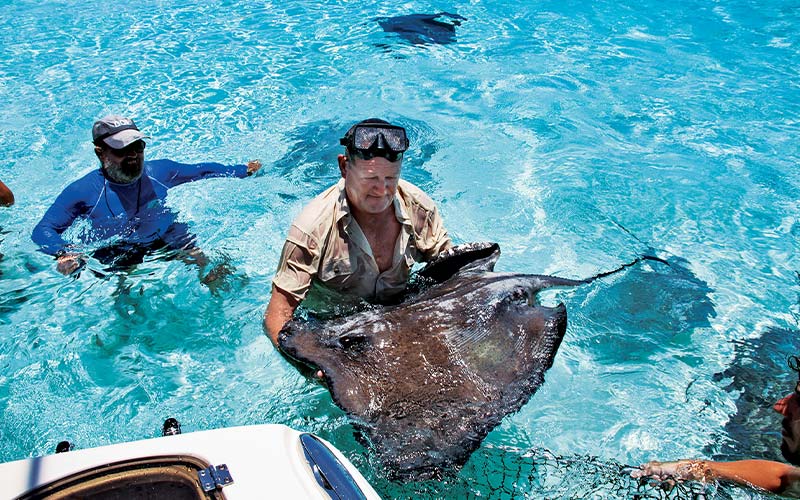HOMETOWN: George Town, Grand Cayman
AGE: 58
YEARS DIVING: 40
FAVORITE DESTINATION: Cocos Island, Costa Rica. I was able to visit last August for the first time in a decade, and the reefs were as amazing as ever. We noticed some big changes, however, including an increase in the number of tiger sharks and a large decrease in the number of turtles.
WHY I’M A DAN MEMBER: DAN is a wonderful organization that provides a unique and excellent service. Why wouldn’t I be?
We’ll begin by stating the obvious: Guy Harvey, Ph.D., is a phenomenally gifted artist. His dynamic portrayals of marine life grace — among other things — canvases, books, apparel, murals, a specialty license plate and even a purposefully-sunk shipwreck. This alone is remarkable, heady stuff. Look past the obvious to his other accomplishments, however, and the term “artist” becomes thoroughly inadequate. Harvey’s efforts to promote the magnificence, mystery and fragility of our ocean extend far beyond artwork, encompassing intriguing documentaries, intensive scientific research and hands-on labor to encourage the enactment of conservation laws.
AD: Guy, some of your most distinctive work depicts billfish, and it’s said that your initial inspiration came from an Ernest Hemingway novel.
Harvey: That’s right. I grew up on Jamaica, and I was about 15 when I first read The Old Man and the Sea. I didn’t know who Hemingway was, but I knew about blue marlins because my parents used to speak about them. These were iconic fish, but they were few and far between. I think the tale seemed so familiar to me because the fishermen in Jamaica fished the same way: tiny boat, absolutely huge fish. When I was 18, I recreated the story in illustration. The result, Santiago’s Finest Hour, was published 17 years later in 1990, in celebration of Hemingway’s 100th birthday. It’s still my favorite story, and there is a replica of one of these scenes in my gallery to this day.
AD: Clearly, sport fishing is as much a part of your identity as diving. You belong to the International Game Fish Association Hall of Fame and, as of November 2013, the International Scuba Diving Hall of Fame as well. This seems incredible to me, as fishermen and divers are often at odds over marine resources. You, however, are well respected and a voice for conservation in both worlds.
Harvey: For me, fishing and diving have always gone together. The ocean has been an integral part of my artwork, and diving allows me to gather inspiration and gain an in-water perspective of marine life. And of course, attracting big creatures often requires fishing. For me, an ideal trip combines both fishing and diving.

AD: You have recently embarked on a new venture, Guy Harvey Outpost Resorts. Will this be a reflection of your ideal vacation?
Harvey: Absolutely. These will be remote, exotic resorts that incorporate both fishing and diving, and they will also provide bases from which to pursue additional research. Of course, with diving being such a major component of the resorts, we plan to work with DAN as we get things set up.
AD: You have two children. Do they share your love of travel and the ocean?
Harvey: Yes — Jessica is 23, and Alexander is 20. They have been diving for half their lives, and both have traveled extensively. Jessica is also a skilled fisherwoman. At one time she held 16 International Game Fish Association world records; two of these records still stand.
AD: You are well known for your work in both billfish and shark conservation. Several years ago I attended a screening ofThis Is Your Ocean: Sharks, a documentary featuring you, Wyland and Jim Abernethy that illustrated the challenges and benefits of changing the way people view these animals.
Harvey: In recent years my conservation efforts have concentrated more on sharks than anything else. It’s funny that you mention that film, because we’ve just released another film called Tiger Shark Express. This new documentary was filmed in four different countries and took five years. We joined with shark researchers, and all of us pitched in to tag tiger sharks so we could investigate their migrations and secret lives. Tagging fish, especially sharks, is hard work, and the tags are very expensive so you have to be sure they’re secure. But it was worth both the effort and the wait because the results were fascinating — these animals travel huge distances, spending about half of the year on shallow reefs and the other half in deep water. We tracked tiger sharks all the way into the North Atlantic. This work was a crucial part of achieving our conservation goals, and our findings were instrumental in persuading the Bahamas to create a shark sanctuary.

AD: Science obviously played a big role. I know you have a doctorate in marine fisheries. How else has this tied into your work?
Harvey: My whole career has been built around science. I completed my Ph.D., and about two years later I left academia to become a full-time artist. Eight to 10 years after that I jumped back into academia with both feet and created the Guy Harvey Research Institute (GHRI) at Nova Southeastern University in Fort Lauderdale, Fla. Scientific knowledge is key to all parts of my work. We must learn about the animals we’re trying to protect before we can teach others about them. With my art, my personal observations and research while diving have been key to creating authentic compositions.
AD: I understand you’re vitally interested in the health of the resident stingray population at Stingray City and sandbar on your home island of Grand Cayman. Explain some of the research you’ve conducted to this end.
Harvey: The census of the stingray population in the North Sound of Grand Cayman was started in 2001 by the GHRI in collaboration with the Department of Environment (DoE) in the Cayman Islands. The history of the sandbar and Stingray City is well known, but nothing was known about the natural history of the species, the southern stingray. Two master’s-degree students did the work for the first two years and tagged 181 animals from the sandbar, 22 from Stingray City and, for a control, another 20 animals that do not get replenished by humans.
Passive integrated transponder (PIT) tagging of individuals allowed us to track an individual’s growth and reproductive patterns. Site fidelity was found to be very strong, the sex ratio was seven females to one male, and growth rates were not affected by replenishment, but reproductive rates may have been increased. Diurnal behavior was changed to active daytime feeding at both sites and quiet dark hours, which is the reverse of normal behavior. A new study this year should provide more data.
The census was carried out in 2005, 2008, 2012 (twice) and 2013 with help from vets who work at the Georgia Aquarium. Blood analysis and ultrasound to test for pregnancy was carried out on each animal. The population at the sandbar was steady up to 2010 but went in decline in 2011. This prompted additional work, which showed a drop from more than 100 animals in 2010 to 17 in 2012 for reasons that are not clear. Natural predation, fishing mortality and sabotage were all possibilities, and when four of the 10 rays found in the Dolphin Discovery (West Bay) facility had PIT tags, it confirmed sabotage — they were taken illegally from the sandbar. The DoE subsequently made them return the rays, despite their objections. It is possible that rays were taken off island in boats, and that further reduced the numbers over a short time. The law was changed on May 17, 2013, to protect all rays in the Cayman Islands from capture by any means. Hooray.
AD: The Guy Harvey Ocean Foundation provides a way to raise funds for scientific research. I assume artwork and other sales help, as well?
Harvey: Yes. A percentage of revenue is split between the research institute and other research pursuits. We have also been fortunate to get funding from other sources, including several state lottery systems and a Florida specialty license plate. Last year we raised $1.4 million for research. With this money we funded 60 different grants, all of which support education and conservation. It’s a very exciting time — we’ve been able to make a big impact the last few years.
AD: I heard a rumor that you got your start in apparel merchandising as a kid by selling T-shirts out of your van. Now you’re raising huge sums of money for research and conservation through merchandising. To state the obvious, this is a meteoric rise in success. How did you do it?
Harvey: You know, I have no idea how that story got out. I never sold anything out of the back of a van. After several successful art exhibitions in Jamaica, Florida and the Bahamas in the mid-1980s, I signed a contract to manufacture a line of apparel featuring my artwork, and in 2004 I signed a new license that will continue for years to come. That’s 27 years — definitely not an overnight phenomenon — and I have worked in the art business for 30 years. So for me, the secret to success has been composing new art all the time, surrounding myself with a good team and plain old hard work.
© Alert Diver — Q1 Winter 2014